Officials are struggling to grasp an economy and job market that, while slowing, continues to perform well amidst escalating prices and interest rates. Although inflation is decelerating, it could be more swiftly than desired by policymakers.
Goldman Sachs believes these trends present an ideal situation, allowing the Fed to stop its rate hikes and thus evade a recession, especially as rent increments start to temper, making inflation retreat faster.
However, Barclays thinks that another rate hike might be on the horizon. This is due to officials wanting more concrete proof of inflation gravitating towards 2% and concerns that persistent COVID-related labor shortages and a robust labor market might continually push wage growth, indirectly raising prices.
The decision on Wednesday to maintain the status quo is a relief for consumers subjected to persistent rate augmentations affecting credit cards, adjustable-rate mortgages, and other types of loans. On the upside, particularly for seniors, bank savings yields are looking healthier after prolonged periods of disappointing returns.
Will inflation decelerate soon?
Fed officials predict their primary annual inflation index, the personal consumption expenditures, to remain at 3.3% by year’s end, a tad higher than their June projection. By 2024’s end, they anticipate consumer price rises to descend to 2.5%, which still overshadows the Fed’s 2% guideline.
A foundational measure that omits fluctuating food and energy items, which the Fed closely monitors, is projected to conclude the year at 3.7%, under the previous 3.9% forecast.
Post-summer 2022, inflation took a dip. However, by August, rising gasoline costs significantly spiked prices, and core inflation also rose, driven by rent, travel, and other services, as shown by another inflation metric – the consumer price index.
How much will the economy expand this year?
Fed predictions place the economy’s growth at a 2.1% annual rate this year, surpassing their 1% June forecast. For the next year, it’s predicted at 1.5%, above their earlier 1.1% estimation.
The economy saw a solid 2.1% growth in Q2 and could potentially witness up to 4% growth in July-September. However, it’s expected to decelerate significantly as the year progresses. Goldman suggests that resuming student loan payments post-COVID, potential government shutdowns, and auto strikes could obstruct growth.
Consumers have yet to significantly shy away from spending, even with the current high prices and borrowing costs, since average pay hikes finally exceed inflation. Yet, economists opine that the resumption of student loan repayments and dwindling pandemic-related savings of households could affect consumption.
Will the job market decelerate in 2023?
The historically low unemployment rate of 3.8% is predicted to end the year at the same level, below the earlier 4.1% prediction. By 2024’s end, it might rise to 4.1%.
Since June, U.S. employers have been adding approximately 150,000 jobs monthly. This is half of what was recorded earlier in the year, but it’s still commendable. There are currently 1.5 job openings for every unemployed American, which, although down from earlier in the year, is considerably higher than a balanced market ratio of one job opening per unemployed individual.
Yearly wage growth declined to 4.3% from March’s 5.9%. However, Barclays notes that the rate remains above 3.5%, pushing inflation down to 2%.
Last month, during the Fed’s annual conference in Jackson Hole, Wyoming, Fed Chair Jerome Powell stated that rate hikes could be possible if the economy and job market didn’t weaken significantly.
But, Powell also expressed the Fed’s intention to proceed cautiously, balancing rate hikes to control inflation without pushing the economy into a downturn.
Are you interested in more insights on interest rates, inflation, and the economy? Continue reading.
10-year Treasury yield
The Fed’s decisions have inflated the 10-year Treasury bond yield, a benchmark for setting a 30-year mortgage rate. The result reached its pinnacle since November 2007 on Tuesday and was trading at 4.331%, a tad less than 1%, by Wednesday afternoon.
What is hyperinflation?
Hyperinflation denotes a highly rapid price rise. There isn’t an official threshold, as the Federal Reserve Bank of St. Louis clarified.
Although U.S. inflation hit 9.1% in June 2022, it wasn’t labeled hyperinflation. As a reference, Zimbabwe once experienced hyperinflation, where the rate exceeded 20,000%, as cited by the St. Louis Fed.
Federal Reserve System definition
The Federal Reserve System, or the Fed, is the U.S. central bank. Its duties encompass:
- Modulating money and credit to aid in job creation, stabilize prices, and manage long-term interest rates.
- Overseeing banks and other financial entities.
- Upholding the financial system’s stability and mitigating systemic risks.
- Offering financial solutions to the U.S. government, financial institutions in the U.S., and foreign institutions.
- Assisting in the operation and supervision of the country’s payment systems.
Why was the Federal Reserve instituted?
The Federal Reserve was inaugurated by Congress in 1913. As per the Fed’s official website, President Woodrow Wilson endorsed the Federal Reserve Act that year to “endow the nation with a more secure, flexible, and consistent monetary and financial framework.”
U.S. inflation rate by month
Inflation has significantly reduced, plunging over half from its zenith of 9.1% in June 2022. Yet, it’s still overshooting the 2% benchmark the Federal Reserve prefers. For a detailed monthly breakdown since May 2022, click here.





